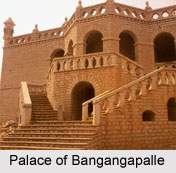 Banganapalle is a princely town and this place is scattered with numerous palaces and zamindari houses.
Banganapalle is a princely town and this place is scattered with numerous palaces and zamindari houses.
Location of Banganapalle
Banganapalle is located in Kurnool district of Andhra Pradesh. The area of the state is 255 sq. m. Banganapalle is located at 15.3167 and degree North to 78.2333 and degree East. The average elevation of the state is 209 meters (688 feet).
History of Banganapalle
In 1601, the fortress of Banganapalle was conquered by Sultan Ismail Adil Shah of Bijapur from Raja Nanda Chakravathy. The fort and the surrounding districts were under the clutches of his victorius general, Siddhu Sumbal. He dominated the place until 1665.
Bangangapalle and its surroundings were granted to Muhammad Beg Khan-e Rosebahani in perpetual fiefdom. As he did not have a male heir, the city came under the rule of his adopted son, Faiz Ali Khan Bahadur. Aurangzeb, the Mughal emperor conquered the Sultanate of Bijapur in 1686, but it was secured back by Mubariz Khan, the maternal uncle of Faiz Ali Khan.
Banganapalle was ruled by the descendants of Faiz Ali Khan. Faiz Ali Khan also died without a male heir, and Banganapalle was inherited by his grandson, Husain Ali Khan.towards the end of his reign, Hyder Ali of Mysore was expanding his power in the reign. Husain Ali Khan switched his allegiance to Hyder Ali. In 1783,Husain Ali Khan died and his young son, Ghulam Muhammad Ali, succeeded him, with his paternal uncle as regent.
Within a year Hyder`s successor Tipu Sultan drove them from Banganapalle and they had to take refuge in Hyderabad. In 1789, he returned to claim back Banganapalle. After which, the nearby jagir of Chenchelimala was acquired by the nawab of Banganapalle through marriage.
In the early 1800`s Banganapalle became a princely state of British India. The British governor of the Madras Presidency took over the control of the state twice for financial mismanagement.
In 1948, Banganapalle was incorporated into Kurnool district of the then Madras Presidency. In 1953, the northern districts of Madras state, including Kurnool district, became the new state of Andhra Pradesh.
Tourism in Banganapalle
The place of interests in Banganapalle is Yagati, the sacred pilgrimage centre of Hindus.
Mahanadi, is a village that is considered as a pilgrimage centre of Hindus. In this village is built the Lord Shiva Temple, dedicated to Mahadeva. There is a pool inside the temple which is considered sacred by the Hindus and it is believed that bathing in the pool washes away ones sins.



















